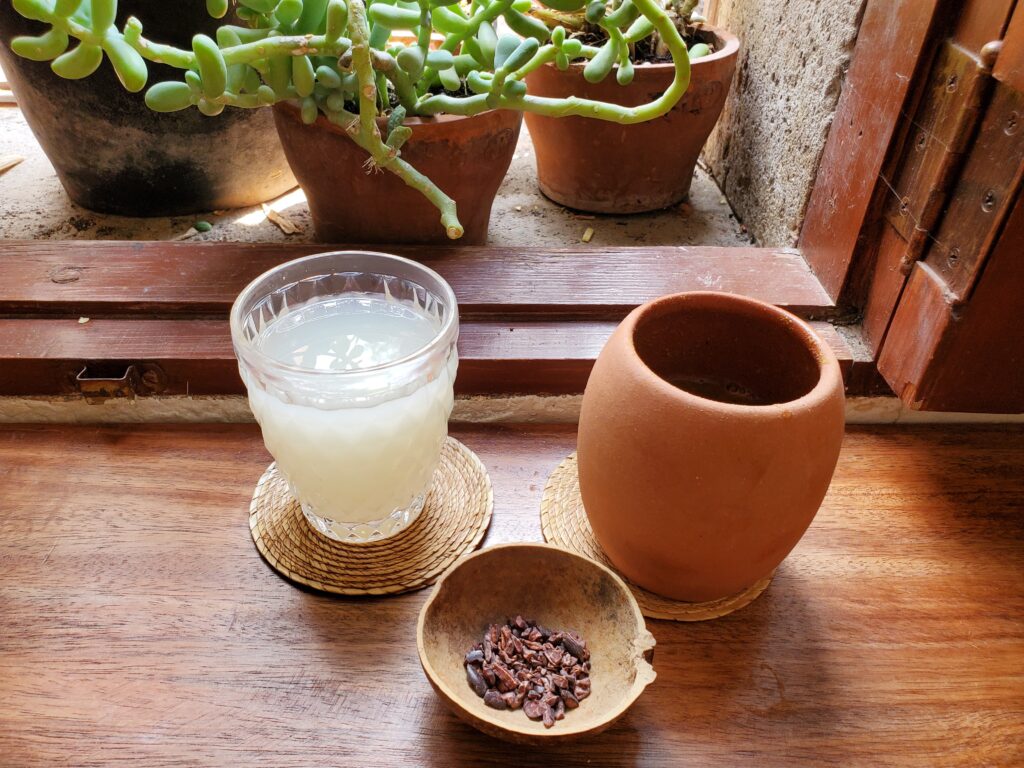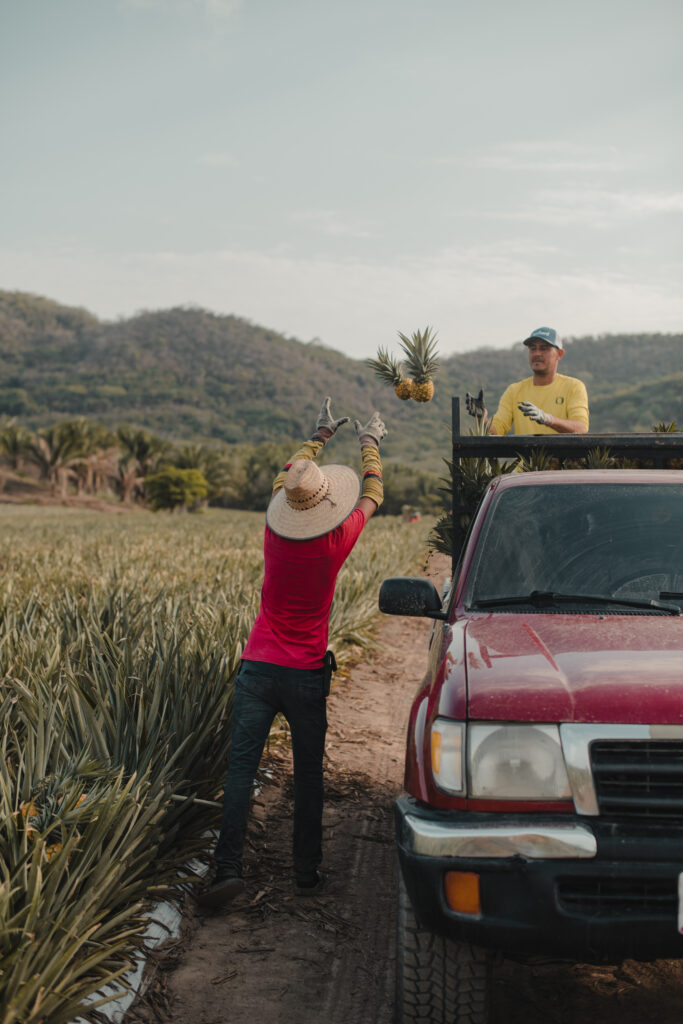Tepache Takes the Stage: The Complicated Popularity of This Fermented Pre-Columbian Beverage
Tepache is appearing behind the bar and in the can, but it has a long and complex cultural pedigree

Fabiola Padilla, owner of San Miguel de Allende’s Bekeb cocktail bar, recalls the first time she ever tasted tepache. “I was very young, and it was from a corner stall in the mercado in my town in the Highlands of Jalisco,” she says. Adds Blanca Benitez, general manager at Seattle’s Mezcaleria Oaxaca, “tepache informed my childhood in Monterrey. We’d buy it from a street vendor after playing in the park, or at the mercado when I went shopping with my mother. It was sold in a small bag with a straw stuck in it.”
Ask most Mexicans, especially if they’re from older generations, about tepache — an effervescent, low-ABV pre-Columbian beverage made from fermented corn or pineapple fruit and/or rinds, piloncillo, canela, and water — and you’re bound to hear similar stories, as well as those of other once-sacred ancestral beverages like tejuino (nixtamalized corn, piloncillo and lemon), pulque (the fermented aguamiel, or sap, of specific maguey species), and colonche (fermented prickly pear tunas).
I don’t recall the first time I tried tepache, but I’ve long been fascinated by Mexico’s indigenous foodways. I met Padilla on a recent trip to San Miguel de Allende, where I was attending North America’s 50 Best Bar Awards (as a side note, some of the world’s most innovative bar programs are coming out of Mexico, notably Mexico City, Oaxaca and Guadalajara) and researching a story on pre-Columbian beverages. Bekeb is one of several acclaimed bar programs, along with La Mezcaleria and Agavia 115, in the UNESCO World Heritage-designated city focused on endemic ingredients and spirits, like Padilla’s Tepache con Piquette cocktail made with tepache, raicilla (an agave spirit native to Jalisco), Ancho Reyes and lime.

Tepache has captivated the U.S. market in certain regions, not just as a housemade cocktail component but a ready-to-drink (RTD) beverage that’s simultaneously sweet, earthy, herbaceous, and slightly fizzy. Many younger Mexican Americans are also unfamiliar with these ancestral beverages, and their increasing visibility is helping to reconnect a new generation to their cultural heritage.
Despite its simple composition, tepache has a long and complex cultural pedigree, which is one reason- along with distribution and the fact that some ingredients aren’t available outside of Mexico — RTD formats and usage in the U.S. are controversial to some. Tepache dates back thousands of years and has been variously attributed to the Mayan people of the Yucatan and the Nahua of Central Mexico; “tepache” is an amalgamation of the Nahuatl words for tepiātl (“drink of corn”) and tepachoa (“pressed or ground with a stone”).

“There are countless hyper regional, terroir-centric fermented and unfermented beverages throughout Mexico and the Americas,” says Luna Vela, an Austin-based pre-Columbian fermented foods consultant and the former director of fermentation at Nixta Taqueria. “Yet, many of them are no longer produced and, despite its current popularity, tepache and other ancestral beverages are all endangered.”
At Nixta, Vela made different types of seasonal tepaches, including pear-chipotle and a green version with pineapple rind and herbs, as well as colonche, mesquite tea, chamoy, vinegars and fruit tibicos, also known as water kefir. She put housemade tejuino on the menu because it holds reverence for our region’s native Tarahumara people. “Serving it here on their native land is about creating awareness for our guests,” she says.
Like many pre-Columbian beverages, tepache was originally made from corn, an ingredient still used in some regions. The introduction of pineapple from its native South America around 700 BC led to tepache’s transition into a fruit-based beverage; sometimes guavas or oranges are used instead. The fermentation process also makes tepache an excellent source of probiotics; it’s still widely consumed in Mexico as a digestive aid and immunity enhancer, as are other fermented ancestral beverages.
That said, tepache is not “the new kombucha,” says Vela. “It makes me sad when I hear that,” she says. “Tepache works as a trend because it’s invigorating and versatile, but that also means it’s ripe for exploitation.”
Vela is referring to the recent proliferation of alcoholic and N/A RTD tepaches from both Mexico and America. Domestically, some brands tout their tepache as a wellness beverage or channel woke culture,” (see sidebar, “Raising the bar”). The bar professionals I spoke to for this story agreed that while frustrating, the popularity of tepache in the U.S. ultimately serves the greater good by creating awareness around pre-Columbian beverages.
Still, reformulating live ferments like tepache or pulque into RTD format is problematic because the process alters its composition and flavor profile of the beverages, sometimes- as with pulque- rendering a different drink altogether. But, says Padilla, the lack of U.S. accessibility to the authentic version of pre-Columbian drinks renders American RTD versions less about appropriation and more about cultural education and access. Benitez, however, stands firm in her belief that ancestral beverages should only be made from scratch, so as not to lose their vitality and “essence,” but also as a way of reducing waste.
Adds Vela, “There will always be people appropriating indigenous food and drink, but there’s room for RTD and other formats if they accurately represent these products and focus on the ecological, environmental, and human welfare aspects of their products. I’d like to see more transparency and small-scale production.”
The macro view for Vela and others is that providing access to tepache and other ancestral beverages- even if they’re a different expression such as distilled, rather than fermented, pulque- is the most important thing. “It’s about education and accountability,” she says. “It’s also crucial to educate your staff, including white cooks and bartenders, about why these ingredients are important and why they were historically used. It would be great if everyone was inspired to learn more about their indigenous food and drink.”
While controlling the narrative surrounding pre-Columbian beverages in today’s marketplace isn’t always possible for bar professionals. But as consumers, we can all be more mindful of what we eat and drink, regardless of budget, in this time of supply chain disruptions and climate change. By purchasing indigenous drinks like tepache, “you’re helping to bring these beverages back from the brink,” says Vela. “I find that really powerful.”

Raising the bar
While you should always drink what you like, most RTD tepache brands miss the mark when it comes to marketing a product that has been a crucial part of Mexican culture for centuries. Two that get it right:
Domestically, Los Angeles’s De la Calle, sets the bar for reinterpreting a pre-Columbian beverage typically made at home or sold on the street into authentically flavored (think tamarind citrus, chamoy, original and pineapple spice) high-quality canned drinks with an educational bent. The company is co-owned by a native Mexican who learned to make tepache from his grandmother. The profiles are fresh and drier than their counterparts.
A Mexican standout is Nayarit’s Tepache Sazón, a small, Mexican-owned and -operated company located in San Pancho, a region is known for its pineapple cultivation. The fruit is hand-picked and combined with only raw piloncillo, yeast and canela; the resulting beverage, which clocks in at 7% ABV and is newly available in the U.S., is well-balanced and the perfect antidote to summer in Texas.
Tepache Recipe
by Blanca Benitez, Mezcaleria Oaxaca, Seattle
The rinds from two pineapples
2 cones piloncillo
7 cinnamon sticks
4 gallons water
Add the rinds, piloncillo and cinnamon sticks in a glass aguas frescas vitrolero or another five-gallon container.
Let sit at room temperature for five days, checking daily. The tepache should produce bubbles, indicating fermentation.
Strain and store in a glass container in the refrigerator for up to four days.


